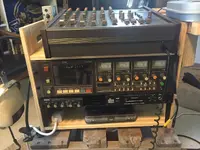R
RFR
Well-known member
Well its about time you came up for air

Hahaha, your studio looks tiny!
Congrats on the new place.

Hahaha, your studio looks tiny!
Congrats on the new place.



 )
)
The #1 reason(s) to use a patchbay IMO is to:
1. Make frequently accessed jacks *accessible* and
2. Join outputs and inputs together that you most frequently or *normally* (this is where the term "normalling" jacks comes from) have connected together.
You would need to connect the 6 insert jacks to a patchbay using insert cables; TRS at the mixer to TS + TS. Each insert would occupy both an in and an out jack of the patchbay...the send and return plugs of the insert cable need to be normalled or signal won't pass from the input jack of the mixer to the rest of the channel strip. You would then patch the input and output of the compressor (for instance) to the send and return jacks on the patchbay for whatever channel you want to insert the compressor.
Does that make sense?
 )
)(Great to see some Linux use in those screenshots )

Another question: what outputs on the mixer do you usually have connected to the audio interface inputs?
Got it all hooked up and look!! another slot available!!

Well, this simply will not do!
But it seems to me you have your effect send and reverb return points mixed up. If you arranged the patchbay like the attached picture shows, you won't even have to add a cable, because your effects send will be automatically fed (i.e. "normalled") to your reverb in, and the reverb out will automatically feed to your effect return.
If this was addressed in an earlier post, forgive me. I missed it.
I guess I’m a little confused here FB. I thought each vertical set of jacks were independent of each other. My Reverb in/out is coming out of the Nanoverb, and the Effect out/return is coming out of the mixer. My thought on this was (I think SB suggested it) if I wanted to add a pedal I can patch through effect in/out. Same with the reverb... patch it through effect in/out. Did I screw up here?

